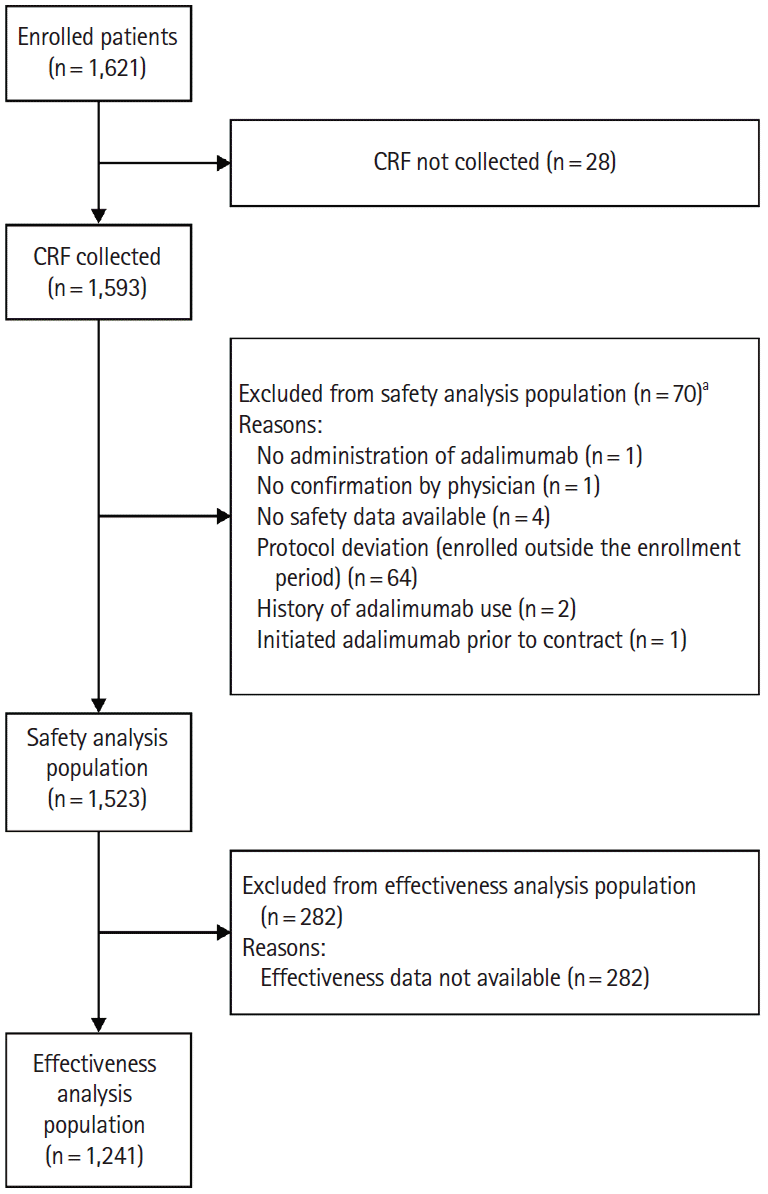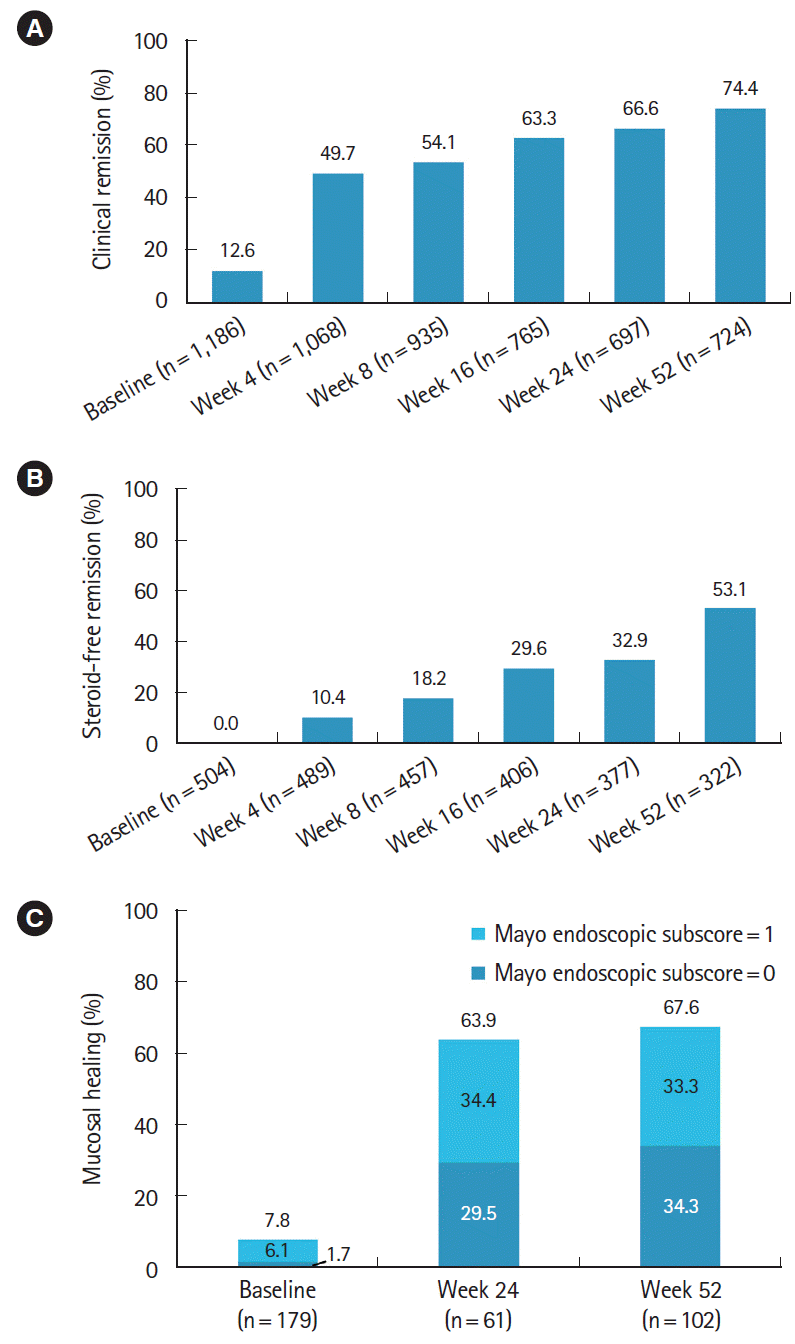Abstract
Background/Aims
Methods
Results
Notes
Conflict of Interest
Ogata H reports receiving financial support for research from Eisai Co. and lecture fees, consultancy fees, and other support from AbbVie GK. Hagiwara T holds stocks/stocks options of AbbVie Inc. and is an employee of AbbVie GK. Kawaberi T and Kobayashi M are employees of AbbVie GK. Hibi T reports receiving financial support for research and lecture fees from AbbVie GK and Eisai Co., Ltd, consultancy fees from AbbVie GK and EA Pharma, and other support from AbbVie GK.
Hibi T is an editorial board member of the journal but was not involved in the peer reviewer selection, evaluation, or decision process of this article. No other potential conflicts of interest relevant to this article were reported.
Author Contribution
Conceptualization, supervision: Ogata H, Hagiwara T, Hibi T. Data curation, formal analysis, funding acquisition, investigation, resources, visualization: Hagiwara T. Project administration: Hagiwara T, Kobayashi M. Methodology, validation, writing - original draft: Hagiwara T, Kawaberi T, Kobayashi M. Writing - review and editing: all authors. Approval of final manuscript: all authors.
Others
This study was funded by AbbVie GK and Eisai Co., Ltd. The sponsors participated in the study design; data collection; analysis and interpretation of data; and writing, reviewing, and approval of the publication. All named authors meet the International Committee of Medical Journal Editors criteria for authorship, take responsibility for the integrity of the work, and give their approval for this version to be published. The standard operation procedures manual for data management and transformation was developed by A2 Healthcare Corporation and approved by the Post-Marketing Surveillance group at AbbVie, funded by the sponsors. Medical writing support was provided by Avinash Thakur and Nicola West of Cactus Life Sciences (part of Cactus Communications) and funded by AbbVie GK.
REFERENCES
Fig. 1.

Fig. 2.

Table 1.
| Characteristic | Safety analysis population (n = 1,523) |
|---|---|
| Male sex | 878 (57.6) |
| Age (yr) | 41.8 ± 16.1 |
| Body weight (kg)a | 57.4 ± 11.8 |
| BMI (kg/m2) | |
| < 18.5 | 306 (20.1) |
| ≥ 18.5 to < 25.0 | 939 (61.7) |
| ≥ 25.0 to < 30.0 | 148 (9.7) |
| ≥ 30.0 | 29 (1.9) |
| Unknown | 101 (6.6) |
| Disease duration (yr)b | 7.9 ± 7.6 |
| History of allergy, yes | 331 (21.7) |
| History of smoking, no | 1,029 (67.6) |
| Comorbidities | 650 (42.7) |
| Prior use of biologics, yes | 408 (26.8) |
| Infliximab | 390 (25.6) |
| Other biologics | 23 (1.5) |
| Concomitant medications, yes | 1,499 (98.4) |
| 5-ASA | 1,310 (86.0) |
| Corticosteroid | 709 (46.6) |
| Azathioprine and 6-mercaptopurine | 664 (43.6) |
| Tacrolimus and cyclosporine | 72 (4.7) |
| Antibiotics | 111 (7.3) |
| Other | 1,187 (77.9) |
| Montreal classification | |
| Proctitis | 37 (2.4) |
| Left-sided colitis | 465 (30.5) |
| Extensive colitis | 1,018 (66.8) |
| Unknown/not provided | 3 (0.2) |
| Partial Mayo score | 5.0 ± 2.1 |
| 0 to < 3 | 198 (13.0) |
| 3 to < 6 | 570 (37.4) |
| 6 to < 9 | 696 (45.7) |
| Unknown/not provided | 59 (3.9) |
| CRP (mg/dL)c | 1.2 ± 2.4 |
Table 2.
| Type of ADR |
Safety analysis population (n = 1,523) |
|
|---|---|---|
| ADR | Serious ADR | |
| All | 276 (18.1) | 74 (4.9) |
| Infections and infestations | 92 (6.0) | 27 (1.8) |
| Nasopharyngitis | 24 (1.6) | 0 |
| Respiratory, thoracic, and mediastinal disorders | 37 (2.4) | 7 (0.5) |
| Interstitial lung disease | 6 (0.4) | 4 (0.3) |
| Upper respiratory tract inflammation | 13 (0.9) | 0 |
| Gastrointestinal disorders | 45 (3.0) | 15 (1.0) |
| Colitis ulcerative | 20 (1.3) | 10 (0.7) |
| Hepatobiliary disorders | 1 (0.1) | 0 |
| Liver disorder | 1 (0.1) | 0 |
| Skin and subcutaneous tissue disorders | 61 (4.0) | 4 (0.3) |
| Rash | 21 (1.4) | 1 (0.1) |
| Musculoskeletal and connective tissue disorders | 21 (1.4) | 5 (0.3) |
| Arthralgia | 10 (0.7) | 0 |
| Lupus-like syndrome | 4 (0.3) | 4 (0.3) |
| General disorders and administration site conditions | 31 (2.0) | 5 (0.3) |
| Pyrexia | 13 (0.9) | 5 (0.3) |
| Investigations | 28 (1.8) | 3 (0.2) |
| C-reactive protein increased | 11 (0.7) | 1 (0.1) |
| ADRs of special interest | ||
| Infection | 92 (6.0) | 27 (1.8) |
| Tuberculosisa | 3 (0.2) | 3 (0.2) |
| Malignancy | 7 (0.5) | 7 (0.5) |
| Injection site reaction | 10 (0.7) | 0 |
| Interstitial pneumonia | 6 (0.4) | 4 (0.3) |
| Autoimmune disease | 5 (0.3) | 5 (0.3) |
| Pancytopenia | 0 | 0 |




 PDF
PDF Citation
Citation Print
Print



 XML Download
XML Download